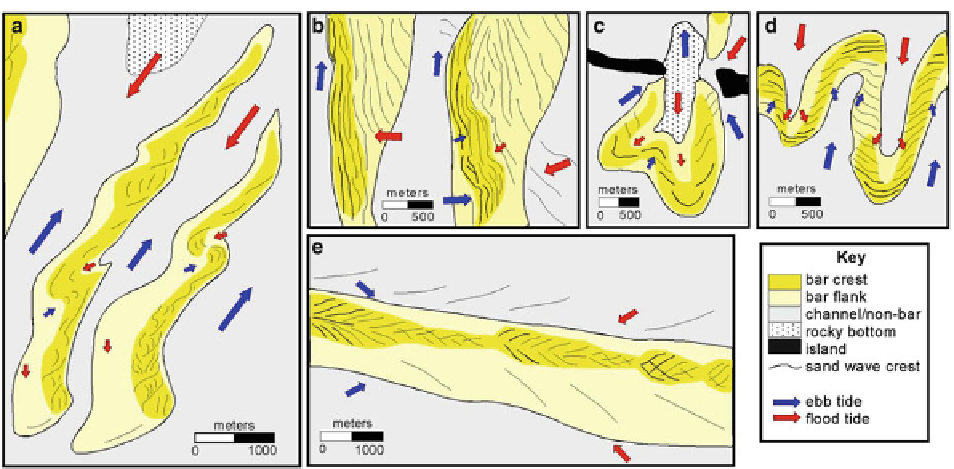Geology Reference
In-Depth Information
Fig. 20.7
Schematic of patterns of bars and fl ood (
red
) and ebb
(
blue
) tidal fl ows in several end-member morphodynamic classes.
Arrows
illustrate general trends in direction of fl ow, not residual
sediment transport directions. (
a
) Longitudinal tidal sand ridges;
(
b
) Transverse shoulder bars; (
c
) Tidal deltas; (
d
) Parabolic bars;
(
e
) Isolated longitudinal sand bars. See text for detailed discussion
can range from markedly asymmetrical (Fig.
20.6f
) to
practically symmetrical, have amplitudes that may
exceed 0.5 m, and be continuous for 1 km or more.
They are ubiquitous on the crests of many tidal bars in
the Bahamas (Fig.
20.6g
), may be exposed at low tide
(Fig.
20.6h
), and are the smallest bedforms discernable
on high resolution (QuickBird or IKONOS, £ 4 m
2
pixels)
remote sensing data.
Not all bedforms on tidal sand shoals are pres-
ently active. On and around most shoals, subtidal
bedforms stabilized by seagrass, calcareous or non-
calcareous algae, non-calcifying microbial mats,
corals, and/or sponges, occur in waters more than a
few meters deep, or on the platform adjacent to the
shoals (Fig.
20.6i
). These features have been variously
interpreted to represent relict deposits (Hine et al.
1981
) or deposits active only during extreme events
(Wanless and Tedesco
1993
), and they can include
complex geometries, perhaps caused by several gen-
erations of activity.
shoal complexes. Within the tidal sand shoals of the
Bahamian Archipelago, sand bars exhibit a wide range
of sizes and shapes. These bars can be grouped into
fi ve end-member classes, each related to distinct mor-
phodynamic processes (Fig.
20.7
). Gradations between
bar-form classes are evident (e.g., shoulder bars with
progressively increasing sinuosity and asymmetry
pass into parabolic bars with linked crests, Rankey
et al.
2006
), and these different barforms can occur
spatially juxtaposed (e.g., the fl ank of a parabolic bar-
form can form part of an adjacent shoulder barform,
Rankey et al.
2006
) or, in some cases, superimposed
(e.g., small parabolic barforms on the crest of tidal
sand ridges).
This empirical classifi cation captures the essential
architectural building blocks of shallow carbonate tidal
sand shoals in the Bahamas. Although it has broad
parallels with, and includes aspects of, previous descrip-
tions from Holocene carbonate shoals (e.g., Ball
1967
;
Hine
1977
; Harris
1979
; Rankey et al.
2006
; Reeder
and Rankey
2008
), it utilizes distinct barform geome-
tries as the basis for description. This classifi cation
shares similarities with aspects of classifi cations pro-
posed for siliciclastic systems (e.g., Off
1963
; Dalrymple
and Rhodes
1995
; Dyer and Huntey
1999
; Wood
2004
) ,
but it differs at a fundamental level because, relative to
siliciclastic counterparts, these carbonate systems all
20.3.4 Barform Morphology
Just as the transport of individual grains constructs
bedforms, the movement of individual bedforms con-
structs barforms, which in turn generate tidal sand

